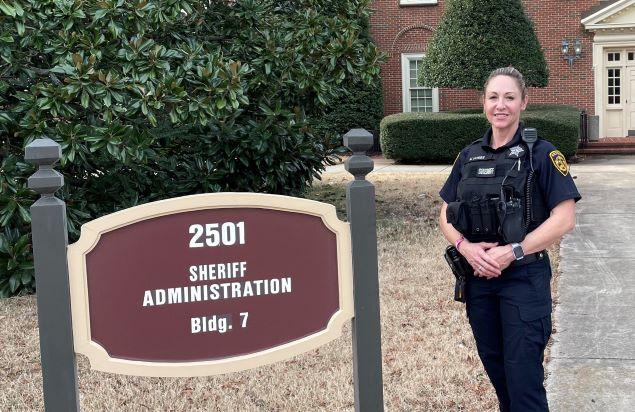Back to Basics: Continued
Jan. 13, 2023: “The light at the end of the tunnel” – FTO and beyond
I hope everyone had a safe and happy holiday season. I want to update you all on my progress through the final portion of my journey, the FTO (Field Training Officer) phase.
After completing my field training with the Courts, Transportation and Civil Process units, my efforts were directed toward completing the remaining portions of my FTO process. Each new graduate received a several-pages-long checkoff sheet that contained a laundry list of criteria that we must meet to complete our FTO phase. I still had numerous topics to cover, including working shifts in Corrections, otherwise known as “working the floor.” Deputies in Corrections work 12-hour shifts, either days or nights, and are assigned to one of four teams. Each team works three or four shifts each week and the teams switch between days and nights every nine weeks. Days off are rotational, so every other weekend, two teams are off work.
I had the opportunity to work with some excellent deputies and supervisors, and my field training officers were top notch. The deputies working on a specific team work the same shifts and have the same days off, so they develop close friendships and become like family.
While working in the jail in both women’s and men’s blocks, I learned the safety protocols and daily duties of the Corrections staff. The jail consists of three buildings, each with different kinds of housing units or “pods.” There are individual cells, open dormitory-style housing and cells that open onto a common area. The jail houses both minimum- and maximum-security inmates, with offenses that range from minor crimes to murder, and their personalities and behavior vary widely. Deputies walk alone through the pods to conduct twice hourly security checks and head counts, and they must have authoritative command presence to maintain control and ensure their safety. And they must be prepared to respond quickly to threats of violence and medical emergencies.
When I was hired by the Virginia Beach Sheriff’s Office to be their first sworn public information officer (PIO), one of the goals was to have me complete the VBSO Basic Academy, get certified and transition into uniform. During my 23 years with the Virginia Beach Police Department and Emergency Communications and Citizen Services, I worked in public information and recruiting. Now that I’m back in uniform, I have transferred to the Community Outreach Division, where I will be a full-time recruiter.
Law enforcement nationwide is struggling to recruit and retain qualified officers and deputies, and we currently have 50 vacant sworn positions. My job will be to augment the current Recruitment Team and come up with recruitment strategies to address that shortfall. I will research and execute new applicant sourcing and advertising opportunities and solicit feedback and suggestions from staff. I have already “recruited” some of my academy classmates to volunteer at some of the events I’ll be working! I thoroughly enjoy engaging with the public and speaking with potential applicants about the VBSO and everything we have to offer. I look forward to creating new contacts in the community and fostering the relationships that I built during my years as a PIO and recruiter. I consider the VBSO my work family and I hope our future staff will, too.
I hope you have enjoyed the Back to Basics blog and all of the experiences I have documented through my academy training. I learned a great deal, including that knees don’t bend sideways! On a serious note, it was amazing getting to know my fellow recruits as we struggled through all the challenges of the VBSO Basic Academy. Who knew doing burpees and having your nose inches from the ground on the “Field of Fun” doing hundreds of pushups could produce such strong friendships?
If you or someone you know is interested in joining our team or have employment questions, visit vbso.net/sworn-positions or vbso.net/civilian-positions or contact me at mhobbs@vbso.net. Thank you for following me on this journey!
Dec. 2, 2022: “Full circle”
It’s amazing how different everything looks from another perspective.
When I was in the Virginia Beach Police Department (VBPD), I experienced courts in a much different way than I experienced them this week working on the “other side” in VBSO Courts and Civil Process. In the VBPD, my court preparation included ensuring that I arrived in plenty of time, having all of the evidence I needed checked out from Property & Evidence, preparing thoroughly for my testimony by reviewing my case notes and felony files, going to the courtroom to check in, and waiting for my case to be heard. While I waited, little did I know the complex web of processes that had to take place behind the scenes to allow the courts to function.
This week my graduate class is completing our field training for Courts and Civil Process and were part of that complex process that takes place to ensure cases are held in a timely, effective and safe manner.
The deputies in the Civil Process unit go out every weekday and serve court paperwork, including summonses, subpoenas to testify in court, garnishment paperwork and civil case paperwork, to name a few. This paperwork helps bring all parties and witnesses to court to testify or appear for a charge or civil case. Civil Process also completes evictions, and two or more deputies arrive with the property owner’s maintenance staff to change the locks on the property. If anyone is on site, they are directed to exit the residence or they will be trespassing. The eviction process includes many steps initiated by property owners through the courts, including lots of notice to the tenants. While working one day with Civil Process, we served 76 documents throughout the city!
The courts determine what cases will be held in which courtroom and on what date. Then the VBSO Courts Division has to determine how many defendants in custody (inmates) need to be brought over from the Correctional Center and how many deputies and transport vehicles must travel to pick up inmates needed from other jurisdictions. All of these moving parts require extensive planning.
At the beginning of the court day, the security screeners at the front entrance check everyone coming into the building for contraband and weapons. This thorough process is our first line of defense to keep our courthouse safe. There is a minimum number of deputies needed to transport inmates in and out of the correctional facility, as well as a minimum number needed to escort them to the various areas of the courthouse where their cases are being heard. It’s not uncommon to transport more than 10 inmates at a time over to the courts lockup, where they are sorted and directed to the areas where they are needed for court. Part of my training was to help collect the inmates needed for court, pat them down for contraband, put them in leg irons (cuffs around the ankles) and attach them to the “daisy chain”. This allows us to attach one wrist of each inmate to a long chain to allow for secure transport to courts. We utilize an underground tunnel that goes from the jail to the courthouse.
Consider that there are more than 20 courtrooms in session simultaneously during the day and you can imagine the coordination necessary to make the process work. While I worked with our court deputies serving as courtroom security (bailiffs), I saw how quickly everything had to sync to flow efficiently. If a defendant is taken into custody in the courtroom, another deputy needs to be available to step in. If a defendant is needed from lockup, a court transport unit will be contacted over the radio to bring the inmate to the appropriate court. Keep in mind there are a limited number of holding cells and inmates have to be separated; men and women cannot be housed within view or sound of each other, and juveniles must be kept separate from adults.
After the inmates have had court, they have to be transported back to their facility of origin. The amount of paperwork needed to process inmates is immense. For example, any time a juvenile is transported to or from the Juvenile Detention Center, a custody order must be created. So, that’s one order to pick them up for court and one to take them back.
Deputies in the courts are also responsible for ensuring the safety of the judge and their clerks, the prosecutors and defense attorneys, and the witnesses and court attendees. They have to also maintain order in the courtroom, ensure the safety of everyone inside the building, and stop any fights or disturbances. As you can imagine, court hearings can get heated – people’s families and freedom can be on the line – so this can be a challenging job.
After all the cases are heard and the courtrooms are vacated, the courtrooms are searched and secured. There is also a master control room with numerous monitors that display video from all over the courthouse: the courtrooms, the secure areas and the exterior of the building. The court staff assigned there act as the eyes and ears of the building and can quickly send backup if needed or lock and unlock doors in secure areas.
At the end of the day, everyone meets up to “sign out,” making sure everyone is accounted for. It makes for a long, exhausting day, but it was a great experience to see full circle how the courts work behind the scenes. I was paired with fantastic training officers who were patient with all my questions. I am a firm believer that asking questions is the best way to learn, and field training week is the time to do it! I have a great respect for how the deputies and supervisors in Civil Process and Courts work tirelessly to make the system work. It was a real eye opener.
Next week I will be working in the Recruitment Office, which is my full-time assignment with the VBSO, but I will write another blog when my field training continues. Thank you for continuing to follow my journey! And don’t forget, if you’re interested in joining the Virginia Beach Sheriff’s Office as a deputy recruit, we are accepting applications until midnight on Dec. 16. Details are available at vbso.net/sworn-positions or you can call 757-385-8808 to talk to a recruiter.
Nov. 25, 2022
Last Friday was a tough day. It was the last day of our Knowledge, Skills and Abilities (KSA) week. We were all on pins and needles waiting to successfully complete the last two scenarios required by the Virginia Department of Criminal Justice Services (DCJS)-required scenarios. It is possible to be let go even on the last day of KSA week, as we have seen happen in previous academies.
Thankfully we all made it! We each passed the required scenarios as well as some additional skills-based scenarios that allowed us to have some fun while honing our tactics and precision shooting. At the end of the week, we were all exhausted from the five-day adrenaline dump, not knowing from one moment to the next what we would face when we entered the live scenario. It tested our ability to think critically and problem solve in a split second. Some scenarios required us to fight a suspect who was actively trying to assault us, requiring us to quickly recall the defensive tactics maneuvers we were taught and apply them to safely gain control of the suspect and avoid being hurt.
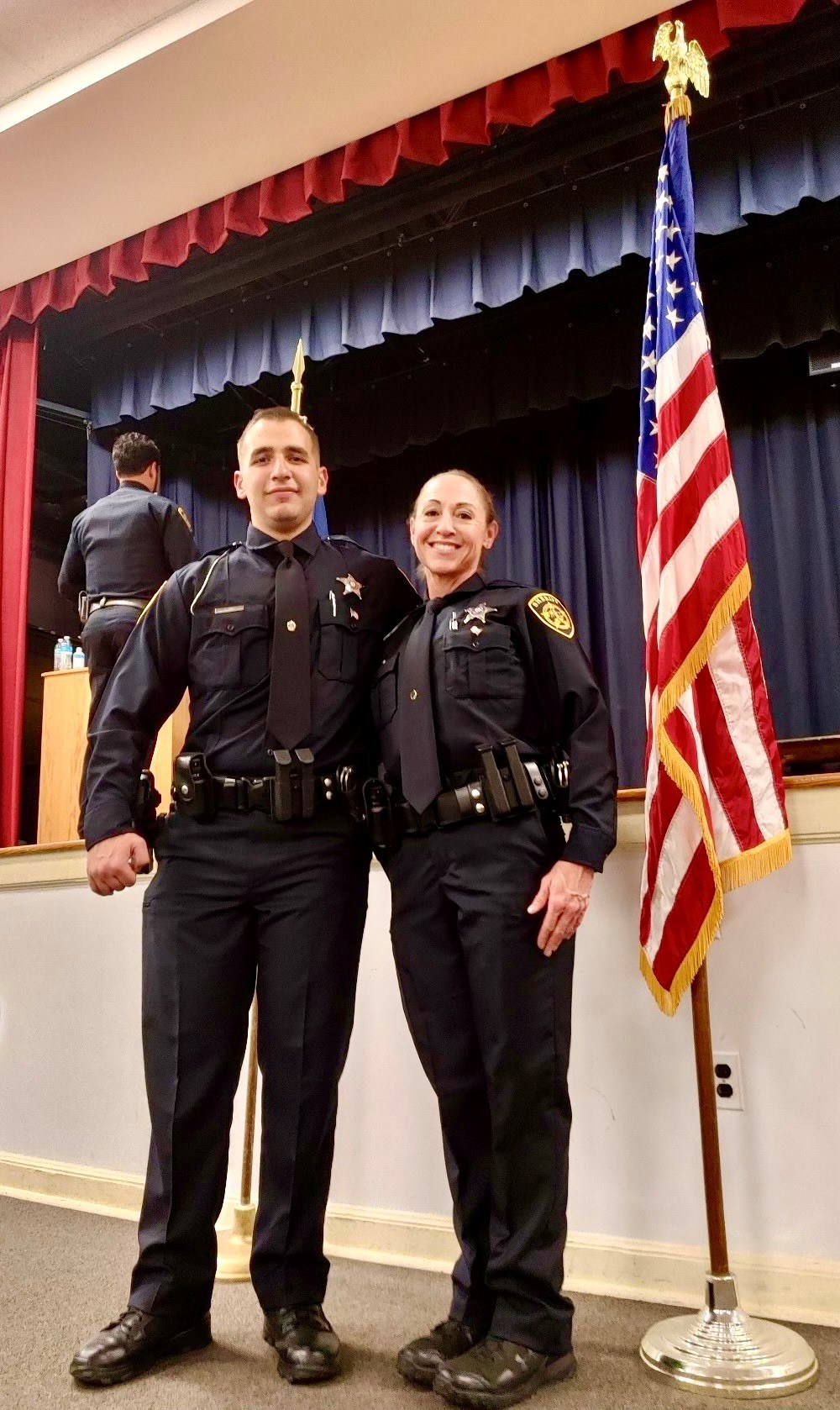
On Monday, we came to the academy knowing that we were almost there, less than two days from graduation. Our class president, Deputy Recruit Willis Tomblin, could tell you how long was left down to the hour! As we lined up in formation at the start of the day wearing our physical training (PT) clothes, the instructors told us to report to the big gym for our “final countdown” PT session. Each academy group has a final grueling workout to commemorate the end of their academy. The academy staff put together a workout that was epic! The workout included five sets of pullups, pushups and squats, followed by four sets of kettle bell swings and slam balls, three sets of box step-ups and toe-to-bar abdominal exercises, two sets of wall balls and crunches, and – at the end – everyone’s favorite: 25 burpees. And once we thought we were done, the instructors had us drop down for another 25 burpees to the song “Final Countdown.” Let’s just say every recruit of every skill level was challenged to push themselves to their physical and mental limits. We were exhausted and sore afterward, and we had to perk back up for graduation practice and preparation for our “big day.” There’s a lot of administrative paperwork and processes that must be completed prior to the end of the academy, such as certification paperwork, firearms paperwork, KSA week scenario documentation, final uniform fitting and scheduling for next week’s field training in Courts and Civil Process.
On Tuesday morning we were expecting to start the day with the traditional “final run” of the academy, but we were perplexed when the instructors led us back to the big gym instead. We soon found out that our high-intensity interval training (HIIT) exercise for the day was going to be a fast-paced, competitive game of dodge ball! What is already a competitive game gets taken to the next level when you put together 16 Type A recruits and extremely athletic instructors. If you got hit by the ball, not only were you “out,” but you also had to do five burpees. Then you would line up to go back in the game when a teammate caught the other team’s ball. Whatever team lost had to do 10 pushups. As soon as that was done, we lined up to do it all again. We must have played at least 10 games, if not more. It was going so fast it was hard to keep count! We were drenched with sweat and out of breath by the end of the games. It was a great opportunity to have a team-based HIIT workout and have some social time with our instructors. Up until this point, they have been in the role of “no-nonsense drill instructor,” so it was great to see their fun side and get to know them better. It also demonstrated that milestone of going from recruit to graduate to becoming a deputy. After graduation we will be part of their team and peer group.
When we graduate, we will also get a raise! Starting pay for deputy recruits is $48,571, which increases to $51,000 once we complete the academy.
That leads me to the final part of the academy experience: graduation. We reminisced about our experiences as we lined up to rehearse the ceremony one last time, hoping we could stay in step and not mess up. We practiced maneuvering into the narrow seats in the auditorium with our gun belts on, and humorously disengaged ourselves from the narrow seats to get up and stand at attention without getting our belts stuck under the chair handles. The mood of the group was really happy, and we were all having a good time talking about funny things we encountered during the academy, recalling some of our tough moments and committing to staying in touch after we left the Law Enforcement Training Academy that night. We were excited to share graduation with our friends and family and for them to know how important they were to our success. Many of us are parents and, with our schedule constantly changing, we needed help from our friends and family with childcare and rides to and from school, sports and activities. In law enforcement, your support system is crucial.

As we lined up to enter the auditorium for graduation, I could feel the excitement in the air. As the doors opened and the music played to signal the start of the ceremony, we marched in cadence around the auditorium, seeing the excited faces of our loved ones and our fellow deputies and police comrades. As we lined up next to our seats, we were all able to sit without getting stuck (whew!). And I’m happy to report that no one tripped, fell or messed up. That was a relief! We cheered on our teammates as they received their certificates and our classmates who won the top academy awards. I looked back on how, only four months ago, we all started this academy as individuals, and we finished as a team. We bonded over pushups, burpees and all the other physical and mental demands of training. Many close friendships were built and will continue to grow after graduation. The academy staff taught us that we must work together to be successful, and we worked hard to become the team of Basic Academy Class 53-22. I was also proud that I was able to overcome my injury and complete the training that I started in February with Basic Academy Class 52-22.

Looking back, I remember lining up for my first academy graduation from the Virginia Beach Police Department (VBPD) in 1999. A lot has changed since then and my VBSO academy experience was very different. Now I’m the mother of two young girls and I have 23 more years of life experience. I learned a great deal in the academy, and honestly I had no idea how many hats our deputies wear today. Now we serve as force multipliers at the Virginia Beach Oceanfront, patrolling side-by-side with the VBPD. We also work part-time security for the schools, the amphitheater, restaurants and entertainment venues. This academy prepared our class for the roles we will fill when we leave the academy and assimilate into the VBSO workforce. As the training staff and supervisors reminded us of many times during the last few days, learning should never stop. We should always look for things to do to stay sharp and improve, such as additional training, challenging workouts and other activities that keep our minds on task and ready for whatever this career sends our way.
Thank you for following my journey with me through the academy! We have a few days off to rest and spend quality time with our families for the Thanksgiving holiday. Then we start our field training (FTO) next week in Courts and Civil Process. We will spend five days working with deputies in those divisions, going one-by-one over the 60+ DCJS standards specific to those areas and demonstrating our ability to successfully transport inmates, provide courtroom security and order, and serve civil process in the community. I am sure I will have some great stories to tell next week of my FTO experience. Stay tuned!
Nov. 18, 2022
We started last week off with our third LawFit assessment, the very last one! Everyone saw improvement from the last test, and a lot from the very first one!
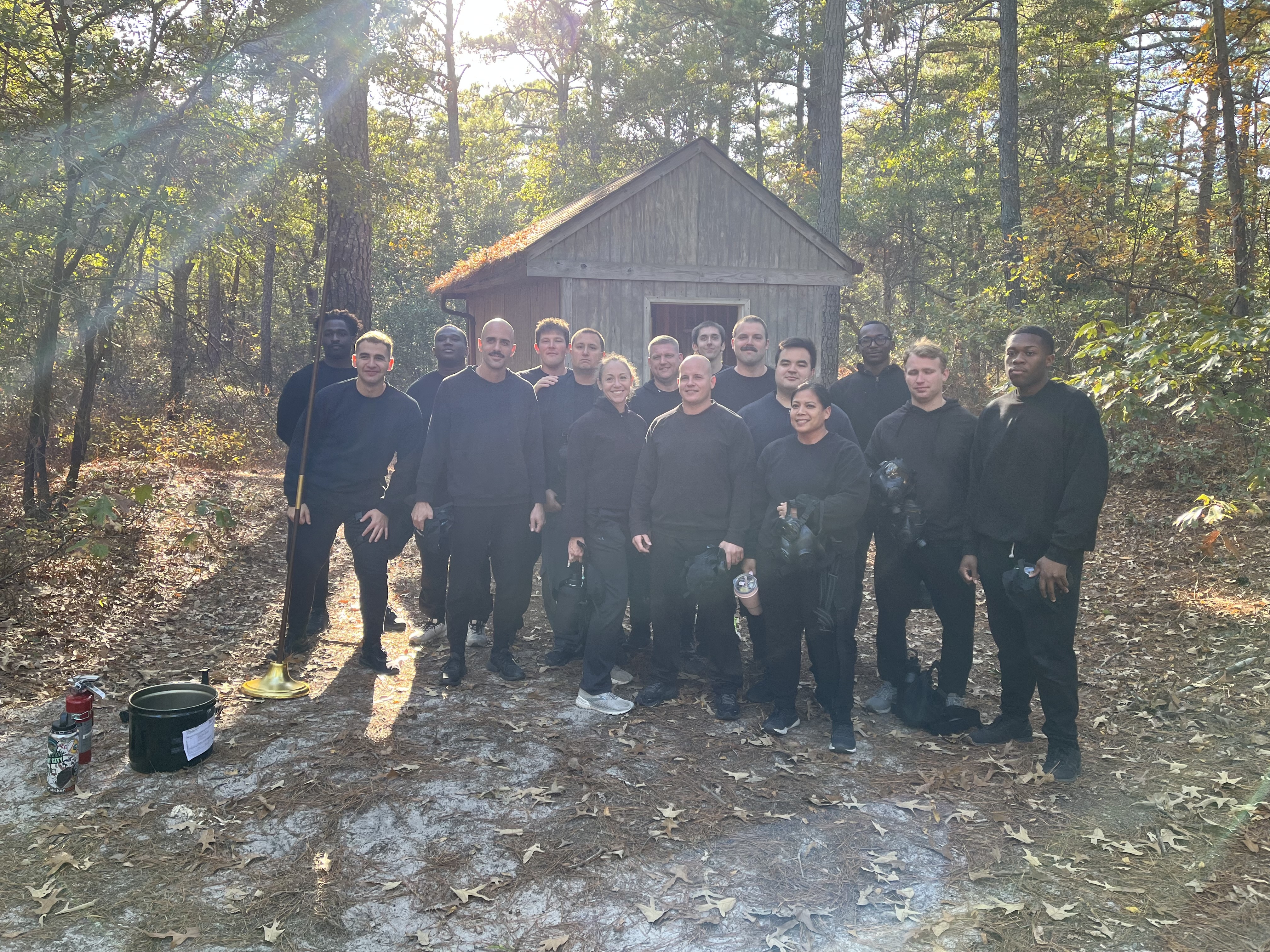
Next we had crowd management and gas mask training. We learned about our issued gas masks and how to adjust the straps on them to create a seal to keep noxious gases out. The instructors set timers for 8 seconds to challenge us to get the command to gas up, get our masks out of the carry bags on our legs, fit them to our faces, adjust the chin straps, get a seal and be back on "the line" ready to hold the "crowd" back. We were then challenged to not only don our gas masks within seconds, but to add the riot helmet, too. We practiced crowd management skills indoors in the gym on the boxing bags and outdoors. Running around with heavy gear and a vest, helmet and gas mask challenged our cardiovascular health. It felt like sucking air through a straw! It was important to practice because the next day we went to the gas house on Fort Story. We entered in pairs, putting on our masks first and ensuring we had a good seal.
On Wednesday we had classroom instruction and practical exercises on combat medical techniques. We learned how to apply tourniquets, pressure dressings and occlusive bandages (for sucking chest wounds such as bullet holes) and how to pack wounds with gauze to stop bleeding. The tourniquet we used in class was very similar to the ones I used in the Virginia Beach Police Department, with some upgrades and new designs. Now the tourniquets are even easier to apply one-handed in case one of our arms or hands is wounded and we need to quickly apply a tourniquet to stop the bleeding and allow us to continue engaging with a suspect (or suspects).
There is a newer version similar to the TheraBands I used in physical therapy after my knee surgery. They are stretchy rubber bands that are applied like a tight ACE bandage and cut off blood supply to the wounded extremity. They are cost effective and easy to use on various extremities and people of different sizes. We applied the various types of tourniquets and self-made emergency tourniquets to ourselves and our partners to ensure they are tight enough to cut off blood flow. You know it is tight enough to be effective when it's painful and you have no pulse in that extremity. Don't worry, we didn't keep them on for long, but it's important to train like it's a real emergency so muscle memory will take over during high-stress situations to allow us to effectively treat an actual life-threatening hemorrhage.
Another medical emergency, hypothermia, is a real threat in this area. We learned the three major contributors to hypothermia - weather, water immersion and shock - and how to treat it.
We finished off the week with active shooter training. We did scenarios inside and outside of the Virginia Beach Law Enforcement Training Academy, and got a feel for the adrenaline, tunnel vision and coordination involved in stopping an active shooter. Friday was the Veterans Day holiday, but on Saturday we practiced active shooter drills in the Virginia Beach Courthouse with role players, radios and realistic training scenarios. The active killing part of most active shooter attacks is over in less than 5 minutes, so time is of the essence! The day was high-paced and adrenaline-packed, but our class took the training we received from our academy instructors and used it to approach each scenario with a plan to successfully apprehend our "active shooter." Teamwork and communication was key to moving safely as a group through the many floors of the building searching for suspects. The training was phenomenal and helped us to prepare for what was coming up this week.
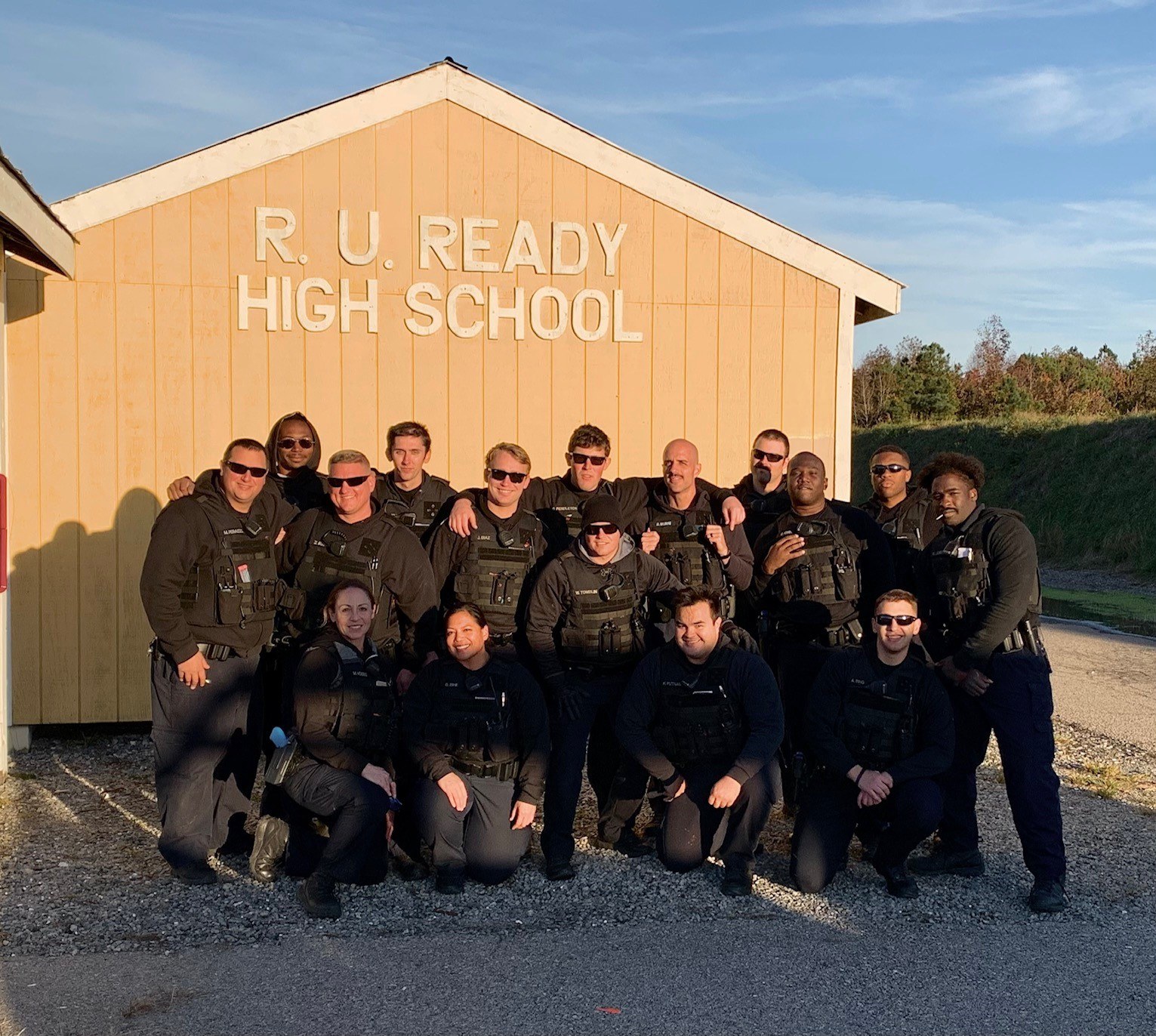
Week 16 could be described as the hardest and most stressful week of the academy. During Knowledge, Skills, and Abilities (KSA) week, we have five full days of scenarios designed to test our cumulative knowledge and mastery of the skills we have learned during the last 15 weeks of the academy. There are Virginia Department of Criminal Justice Services (DCJS) standards that must be met before a recruit can graduate and receive their Basic Jailor and Civil Process certification. Each standard (there are a LOT) must be successfully demonstrated during the scenarios. If a recruit doesn't successfully complete the scenario to the level required to pass, they are given an opportunity to redo it. If they are given the opportunity to complete remedial scenarios and cannot successfully complete them, they are at risk of being administratively separated from the academy. In other words, they'd be "let go" and would be out of a job.
We have all worked so hard the last 15 weeks and none of us are giving up. We had firearm scenarios on Monday and Tuesday and Defensive Tactics (DT) scenarios on Wednesday. DT day is historically one of the hardest. Fighting scenes designed to test our ability to gain control of an inmate while protecting ourselves wore us out! I'm glad all that running has us in great shape (thanks to academy coordinator Deputy Bryan Drew and the rest of the academy staff)!

After training on Wednesday we were sent to the Virginia Beach Correctional Center to participate in a jail-wide search, which takes place twice per year. Recruits worked alongside deputies searching every cell block to look for contraband, such as drugs, hooch (homemade alcohol drink made from rotting fruit) and weapons. The search was successful and several illegal tattoo kits were removed from the facility. That may seem minor, but jailhouse tattoos frequently get infected and can spread disease, such as hepatitis.
On Thursday we returned to the range to complete several DCJS standards on traffic stops, working at the Oceanfront and Civil Process. This tested our tactical skills and situational awareness. I really enjoyed these scenarios, as I have throughout my years in law enforcement.
We still have all 16 recruits on board and today we have our final DCJS-required scenarios. By the end of today we will know who will be walking across the stage at graduation on Tuesday. Wish us luck!
Nov. 3, 2022
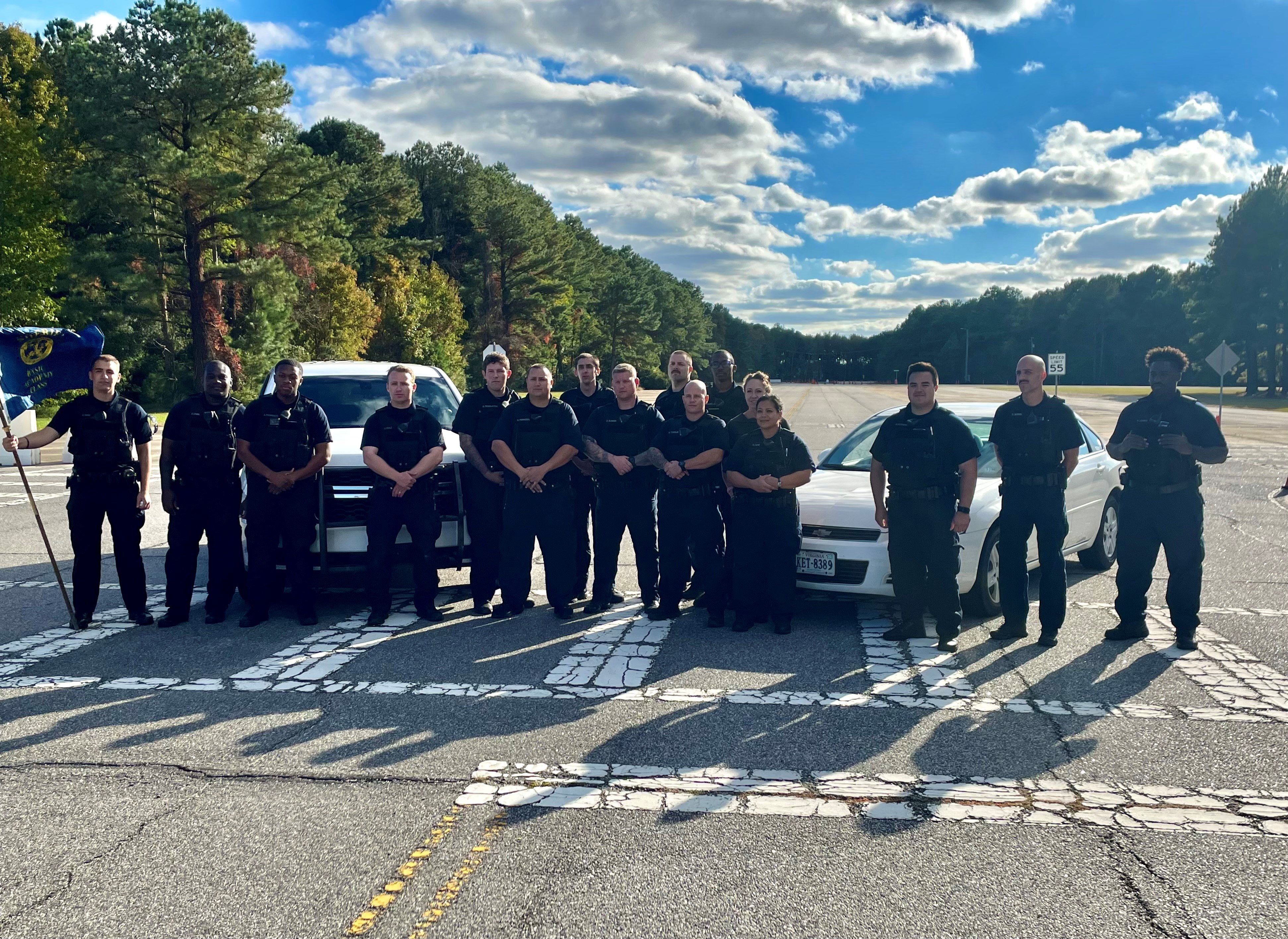
Last week the deputy recruits of Basic Academy Class 53-22 were at the Creeds training facility learning the skills necessary to operate an emergency vehicle. In class 52-22, this training was held earlier in the academy, so I had already completed the course and practical exercises. That turned out to be a real blessing because I ended up being out sick with a bad case of bronchitis. I was able to rest, get better and go out to Creeds at the end of the week to take pictures and cheer on my teammates as they tackled speed and precision drills. We have some amazing drivers in our class. One recruit has a lot of experience driving commercial vehicles and made the courses look effortless! I guess once you’ve driven large commercial vehicles, our VBSO vans and patrol vehicles are a piece of cake. We joked that if anyone ever needs a getaway driver, he would be your guy!
Unfortunately, one of our recruits was unable to successfully complete the precision driving courses required to complete the academy and was administratively separated. It was a staunch reminder to all of us that, while we may be a month shy of graduation, we aren’t out of the woods until we walk across the stage on Nov. 22. On that note, as of today we have just 12 working days of the academy until graduation (not that I’m counting)! We have 16 recruits in our class now, and we are all working very hard to study for our tests and absorb all the information we have learned in the last several months in preparation for our final KSA (knowledge, skills and abilities) scenarios. We are fine tuning our defensive tactics skills and prepping for some scuffles.
This week we learned about Civil Process and Court Security. We had two days of classroom training with some scenarios thrown in for good measure. The last three days our class completed on-the-job training with Courts and Civil Process. You may recall that last academy I tore my meniscus during defensive tactics and was unable to complete the practical exercises because I was on light duty and could not wear my VBSO uniform. But I’m back to full duty now, and on Wednesday was assigned to shadow a deputy in charge of Traffic Courtroom B. I provided courtroom security and assisted with transporting female inmates to the holding areas for court. It was a great learning experience.
After our Courts and Civil Process duties Wednesday, our instructors told us to get changed into our workout gear and to put on “long socks” if we had them. As you can imagine, we usually wear short workout socks, so we were perplexed to say the least. Were we going to be low crawling across the municipal complex grassy areas? Marching through the woods? Some of our former military members guessed that we were going to be running in brush.
Well, they were correct. Our workout was a 3-mile run through the woods near the Municipal Center. It was a challenging blend of jumping over large tree branches that had fallen on the “path” and trying not to trip over countless raised tree roots. I was overjoyed when I was able to catch myself midair after tripping on a large root hiding under some fallen leaves. The leaves covered a lot of the pathways and dodging them felt like being in the game Minecraft.
During our weeks of physical training (PT) in the academy, many recruits’ fitness levels have dramatically improved, and this run demonstrated how far we’ve come and how we work as a team. In group runs the pack has to stay together, which can be challenging when everyone has different running pace. So if we saw a team member falling back, someone stayed with them and encouraged them to push hard and rejoin formation.

During our run the instructor stopped in front of Building 2 and described how on May 31, 2019, our deputies heard the call for an active shooter, grabbed their rifles and ballistic vests, and ran to the scene. He pointed out the distance between Building 2 and Alpha 1, the main staff entrance of the Correctional Center, and described the importance of physical fitness in this job. He said our partners and citizens depend on us to be physically fit to run toward and neutralize any threat. We had just run through the woods with only our PT gear. Now imagine what it was like to run to the active shooter while carrying all your gear, he said. This is why we work as hard as we do during our workouts, and he stressed the importance of maintaining this level of fitness after graduation for ourselves, our law enforcement partners and the innocent civilians who we’re sworn to protect.
It was a somber and important reminder of the job we’ve signed up for.
Oct. 21, 2022
A lot has happened in the last two weeks. They may have started out with paperwork, but they ended with us having two real felony cases. Here’s what happened.
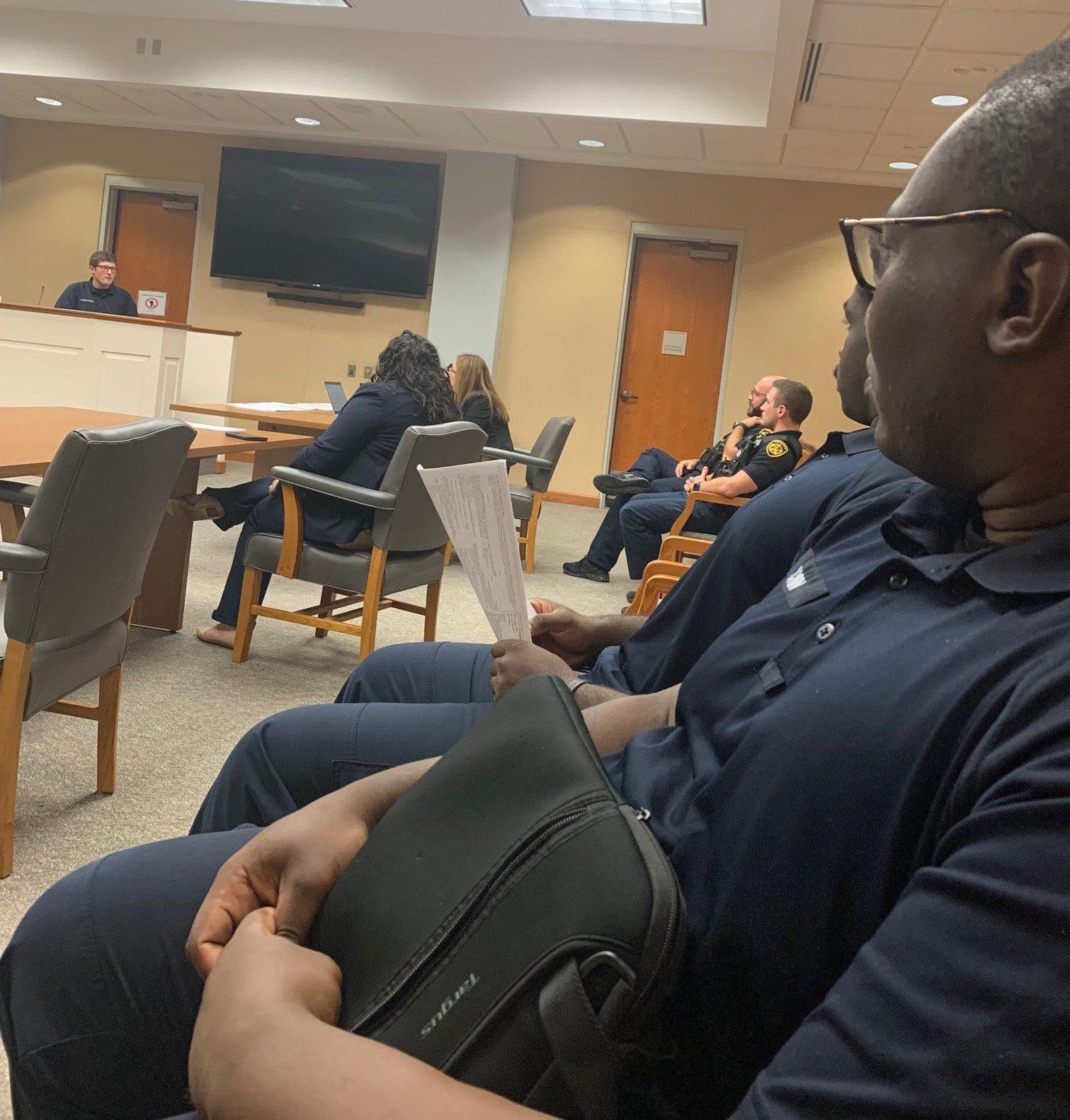
Two weeks ago, our class finished our scenario training by learning how to properly document criminal and institutional rule violations by inmates. After each scenario, we had to complete the corresponding forms for whatever incident was rehearsed and, for criminal cases, there is a LOT of paperwork, especially narcotics cases. Of our many scenarios, we each had one involving a criminal violation that required us to go before a mock magistrate (academy staff) to obtain a “warrant”. My scenario involved finding possible cocaine (a white powdery substance in a clear plastic baggie) in the sock of the “inmate” I was searching before transporting her to court. That meant completing a police report, VBSO Incident Report, inmate violation form, arrest sheet, property voucher and Request for Laboratory Analysis Form. I am familiar with the process for taking out narcotics charges from my time working in the Virginia Beach Police Department (VBPD), but these scenarios helped me learn how the VBSO handles in-house cases of crimes committed by inmates. We each presented our “cases” in a mock Virginia Beach Circuit Court hearing under direct questioning by prosecutors from the Commonwealth’s Attorney’s Office, who played the part of both prosecutor and defense counsel.
Little did I know how soon I would need these skills.
Last Wednesday ended up being a very exciting day for our class. After learning how to properly conduct cell and person searches, it was time to put our training to the test in the Virginia Beach Correctional Center. We mustered in the Emergency Response Team Muster Room to go over our search plan. These searches must be carefully choreographed to ensure that each deputy knows where they’re searching, what items they’re looking for and possible hiding places. We also must be silent upon our approach to the cell block to surprise the inmates and avoid giving them the opportunity to hide or destroy contraband. Under the direction of academy staff and instructors, we escorted the inmates from their cells, conducted pat-downs and secured them in the visitation room next to the cell block.
Then we broke off into two-person search teams. My search partner and I entered our assigned cell and made a plan: he would search the bottom bunk and I would search the top. While I have experience conducting searches for the VBPD, jail searches are much different. Items that are legal on the outside can be illegal inside the jail, such as tobacco and cellphones. The jail also has institutional rules that prohibit excess trash, pornography and items that have been altered from their intended use, such as a pen being turned into a tattoo gun or a toothbrush being sharpened into a weapon. These items can cause fires and undermine the safety and security of the facility. And, of course, drugs are illegal here, too.
While searching our assigned cell I located a hiding spot and found items that my partner and I immediately identified as narcotics. This is where teamwork comes in. My partner is knowledgeable about the jail’s rules, floor procedures and drug identification, while I’m experienced in handling drug cases, including completing the necessary paperwork, processing evidence, preparing a case file and obtaining charges.
At the same time, one of our classmates discovered a man-made weapon in the cell he was searching and took out felony charges. Within 30 minutes of searching, we had two felony cases! Even more importantly, we had removed two dangerous items from the facility, making it safer for both the inmates and the deputies. At the end of the day, that's the whole reason for conducting cell searches.
The next day we learned about off-duty and extra-duty employment. Many deputies work off-duty providing security at concerts, restaurants, hotels and events. In addition, the VBSO serves as a force multiplier to the VBPD, helping patrol the Oceanfront and major events side-by-side with the police. Working in the community is much different than inside the Correctional Center, and it’s essential that deputies understand their role as peacekeepers and the legalities of any action they may take while off-duty. The scenarios we completed brought me back to my police days, and I was really impressed with the storylines that the academy staff came up with to test our understanding of off-duty and extra-duty law enforcement procedures. What's the difference? Extra-duty employment involves a deputy working in uniform in a sworn capacity, whereas off-duty employment does not.
This week our class started out learning how to properly secure and voucher evidence and taking a tour of the VBPD’s Property and Evidence Unit. This came in handy given the evidence that we located during our cell searches last week. The evidence from those two cases – the drugs and the weapon – was vouchered and placed in the Property and Evidence lockers to maintain proper chain-of-custody until the cases go to court. The instructors have asked us many times, “how many of you became deputies because you love paperwork?” So far, I have yet to see a hand raised, but accurate and timely documentation is essential to the job. Failure to do so can cause a criminal case to unravel and undermine safe, effective jail operations.
On Tuesday we met at the jail and received training on receiving and discharging inmates. We learned about the process of bringing arrestees into the jail, including how to transfer custody from the arresting officer to the VBSO. Once again, this involves lots of paperwork, but it is important that we have detailed information on each arrestee to ensure their safety, the safety of their fellow inmates and the safety of the staff. For example, are they in a gang?
As an arrestee is brought in, they are searched by the arresting officer and by a deputy before being taken before a magistrate. There the arresting officer swears to the facts of the case and requests a warrant. If the magistrate finds probable cause, they issue the warrant and determine whether the arrestee can be released on bond. This is based on their charges, flight risk and whether they’re a danger to the community. Those who receive a bond can be released if they meet the conditions, such as posting the bond amount. Those denied bond are taken into the intake area to be searched again and scanned using the body scanner to ensure they do not have anything hidden inside their bodies. Arrestees will secrete drugs, weapons and many other items in an attempt to bring them into the jail or prevent discovery by law enforcement. In fact, during training we saw a scan where a woman had hidden a watch inside one of her body cavities. It would be quite disturbing to have an alarm go off in that circumstance. In other cases we’ve discovered heroin kits, cigarettes and even a set of handcuffs.
Next one of our jail nurses evaluates each arrestee to determine whether they need medical attention or should be placed in specialized housing for detox, suicide watch, medical or mental health issues, or protective custody. Then they’re fingerprinted, photographed and taken to private location for a final search and to change into a jumpsuit. Jumpsuits are color-coded by classification (or, in other words, by housing status). Most wear orange, but we also have green for kitchen trustees, yellow for inmates with disciplinary issues and a few other fashionable options.
On Wednesday and Thursday we had Crisis Intervention Team (CIT) training. CIT is a program designed to teach law enforcement about interacting with those suffering from mental illness. We watched a video of a former firefighter who started experiencing symptoms of depression mid-life and eventually had visual and auditory hallucinations. He stressed how the voices in his head would tell him that law enforcement officers were a threat and explained that people in that state may hear voices telling them to kill them. That’s why this training is essential to helping law enforcement officers bring incidents involving those with mental illness to a safe conclusion. The person may not know what they’re doing or understand that police are trying to help, and it takes a special skillset to deescalate the situation, avoid harm to those involved and get the person the help that they need.
We participated in an exercise called “hearing voices” that helped us understand what a person with schizophrenia or psychosis may experience. We wore headphones that played voices yelling and whispering insults and random words and then were asked to complete various detail-oriented tasks while trying to tune out the voices. We were given a few minutes to write out the words to the national anthem, solve math problems and complete everyday tasks that are easy for most people. Remembering the words for the national anthem may be challenging for some folks (I will not name names), but imagine doing so while listening to multiple voices clamoring in the background! Our class had various responses to these exercises. Some struggled to tune out the background noise, some were irritated or disturbed by the content and some were able to drown out the noise and complete the tasks effectively. Either way, it gave us a lot of empathy for what these people go through.
Sheriff Ken Stolle has frequently said that mental health is the biggest challenge facing public safety, both in the community and inside the jail, where 68% of inmates suffer from a mental illness. That’s why CIT training is so important and why law enforcement must be trained to effectively communicate with individuals suffering with mental illness while maintaining public safety and officer safety.
Our workouts have really been ramping up as well. Everyone was wobbling one morning after we completed a leg “blowout” (as some of us playfully called it), which involved multiple rounds of weighted squat jumps, Bulgarian split squat jumps, plyometric jumps across the gym and jump squats using the TRX bands. If you’re thinking about applying for the Sheriff’s Office, I recommend working some of these exercises into your fitness routine (definitely don’t skip leg day!).
We are one week closer to graduation! Thanks for sticking with us and wish us luck as move into our final weeks of training.
Oct. 7, 2022
This week we had a few schedule changes, courtesy of Hurricane Ian making its way into our area. The storm brought significant amounts of wind and rain as Monday progressed. While the strong winds lifted the vent covers on the roof of the Law Enforcement Training Academy gym, we were being timed to see how many sit-ups we could complete in 1 minute. We pushed as hard as we could, working to the “drip drip drip” of water leaking through the roof vents and into buckets on the gym floor.
Sit-ups are just part of our LawFit assessment. Next we went into the weight room and completed the sit-and-reach, lat pull downs and bench press. LawFit has a scoring system that takes into consideration each deputy’s age, weight and gender. For example, the bench press score is determined by the percentage of the deputy’s body weight that they can lift. I was impressed by how much weight my fellow recruits could bench press and shocked at how flexible some of the men in my academy were at their sit-and-reach tests. Seeing one of our big muscular guys folded in half with a sit-and-reach score of more than 40 cm was a sight to see!
Usually LawFit also involves a 1.5 mile run and obstacle course. But the wind and rain made it too unsafe. The obstacle course looked like a slip-and-slide of mud and grass.
On Monday afternoon we reviewed the videos of our class’s defensive tactics scenarios. A huge improvement from when I went through the Virginia Beach Police academy 23 years ago is the use of technology in the training process. Being able to review video footage of our scenarios helps us critique ourselves and improve. As Cpl. Ron Asuncion, one of our defensive tactics instructors, said, many times what we remember about a scenario and what really happened are quite different. So the videos are a great learning tool.
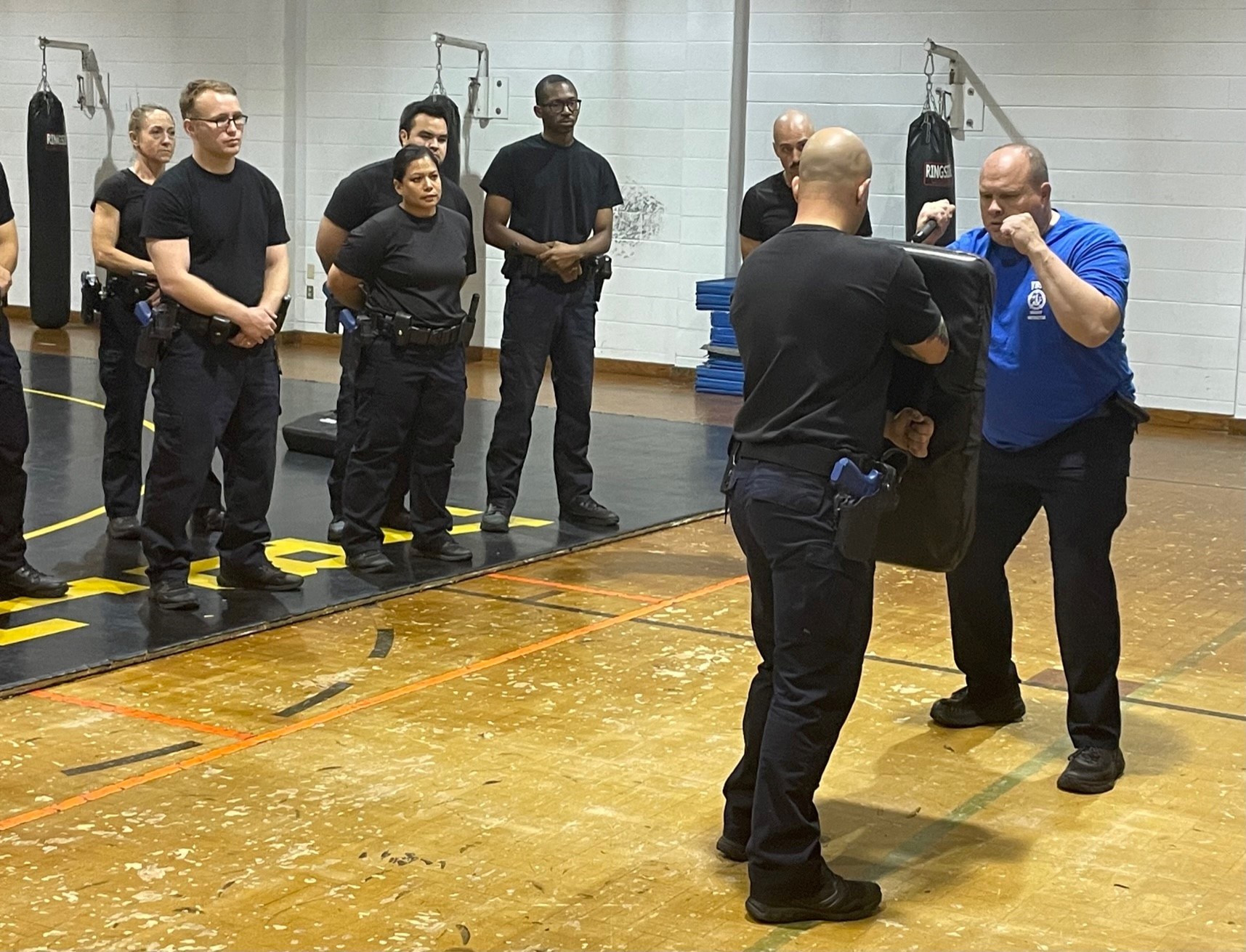
Our academy instructors kept us plenty busy while we waited for more favorable conditions for the outdoor portions of LawFit. On Tuesday we went to the Virginia Beach Courthouse for a tour and some classroom instruction on Court Security and testimony. We had the opportunity to watch court testimony in General District Judge Sal Iaquinto’s courtroom and afterward had a Q&A session with him. He answered our questions and gave us some helpful hints for giving successful court testimony.
Afterward we moved to an empty Juvenile and Domestic Relations District courtroom, where we practiced court procedures. I was the bailiff for my scenarios and had the opportunity to bring out my stern voice (my daughters call it my “mom voice”) and my “mom stare” while my fellow recruits role played as people acting out in the courtroom. Recruits played the roles of the prosecuting deputy, bailiff, judge, Court Transportation Unit and inmate. Role playing allowed us to become familiar with how the VBSO Court Security Division runs the courtrooms. It’s their job to ensure the safety and security of the building, protect the judges and ensure appropriate decorum so that hearings aren’t disrupted.
Police officers spend a lot of time in court, so I have had my fair share of court appearances. It was a unique experience to see the court process from the other side of the courtroom. Sheriff’s deputies don’t have the volume of court cases that police officers do, but they are responsible for the security of the judges, the building and its occupants.
After our instructional period and tour of the Courthouse, we made our way back to the Virginia Beach Correctional Center next door, where it was time for physical training (PT). Unfortunately, some of our classmates forgot their PT gear, which meant that we all had to PT in our uniform pants, T-shirt and boots. We received some “correctional PT” in the front grassy area in front of the building, and passersby got to see us doing high-paced, nonstop body-weight calisthenics, including burpees, lunges, push-ups, air squats and, last but not least, the cliffhanger. We were told we had one final exercise to do: 6-inch leg raises. These require you to lay on your back, pike your legs and keep them straight, with your feet flexed and held 6 inches off the ground without touching. If we could all hold this position for 30 seconds, we were done for the day. Keep in mind, we had been doing high-intensity exercises for the last 45 minutes and were pretty tired. Everyone helped motivate each other, going so far as to ask random questions to distract each other. I overheard one recruit ask another what type of engine their sports car had. I am happy to report our group embraced the suck and did it!
On Wednesday morning we got ready for PT and lined up outside in preparation for our 1.5-mile LawFit run. We lined up at the starting line and heard the countdown from Deputy Bryan Drew, our academy coordinator. Then off we went! This was my first LawFit assessment with this academy class and I was curious how my pace would compare with my classmates. Our class is mostly male, with 15 men and just three women. We have some great runners in the group. Right off the bat our class president took the lead. A few of us stayed pretty close together through the first two laps of the course and started spreading out more as the last lap started. I am used to training for races with my smart watch and it’s difficult to pace myself without it. I pushed as hard as I could and came in second with a time of 11 minutes and 16 seconds. I was thrilled because that was faster than any of my previous LawFit assessments. All my physical therapy and training has paid off! We’ll still have to do the obstacle course at another time because the ground was still too wet and treacherous.
We spent of the rest of the week on retests from previous exams, arrest and transportation scenarios, and preparing for our upcoming court testimony practical evaluations. Tune in next week to see how we do!
Photos by Public Information Officer Toni Guagenti
Sept. 23, 2022
My first training block with Basic Academy Class 53-22 was scheduled to start right after lunch on Sept. 13. It felt a bit weird going back into the classroom and picking up my training in this class’s seventh week. My new classmates already had almost two months together, learning each other’s strengths and weaknesses and personality quirks and getting into a daily routine.
Right off the bat, I noticed several differences. I noticed that all of the gear that my previous academy class (BAC52-22) had carefully organized on our duty belts and vest carriers was no longer where we’d placed it. During each academy, the staff goes over the proper placement of duty gear and walks recruits through it step-by-step. The class president helped me disassemble my duty belt and reconfigure everything in the last three minutes before we had to line up for inspection. It is this kind of teamwork that I experienced on day one that demonstrates how law enforcement officers look out for each other. I thanked him profusely. With his help I was able to be in line for inspection on time and with my gear in proper order, uniformly displayed like my new classmates.
In class 52-22 I had to learn to reach for my vest carrier for magazine pouches instead of my duty belt, which was the location when I served in the Virginia Beach Police Department years ago. Now I have to relearn my gear placement once again. I’m sure when I go to the range I will be reaching for my flashlight on my vest when it’s now located on my belt. However, this academy class is the first to get the next generation of the Glock handgun with upgraded sights and a mounted flashlight. Since the handheld flashlight will no longer be required at the range, I understand why the flashlight has been moved to our duty belt.
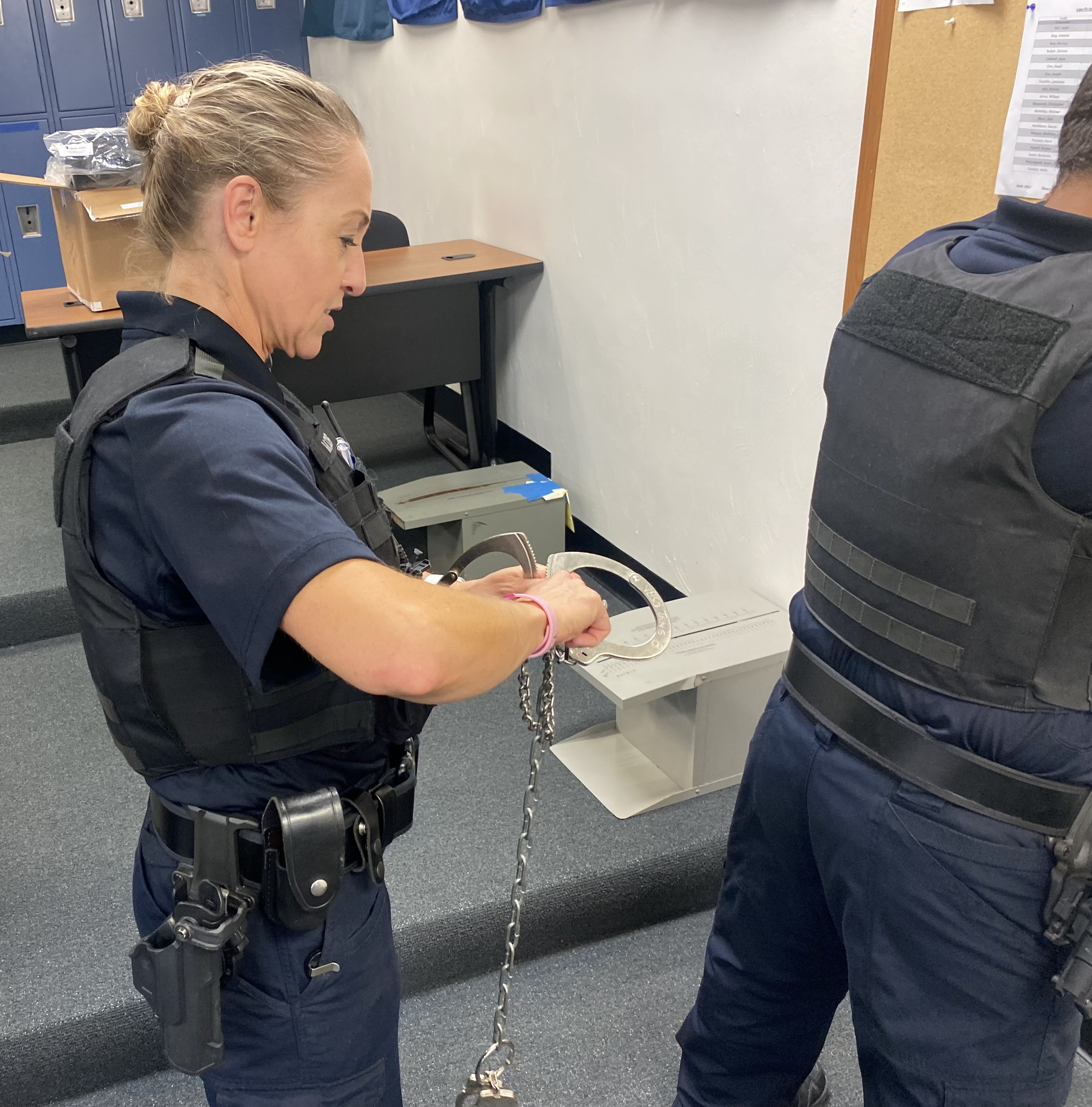
Another difference with class 53-22 is that they meet up at 7:30 each morning, a half hour before the 8 a.m. required reporting time. They say the Pledge of Allegiance and read the Deputy Code and the Warrior’s Creed. They get a head start on the 100 mandatory daily pushups and usually get at least 20 completed before our physical training (PT) begins. Each recruit is expected to complete the daily remedial PT exercises, even if they scored high on the physical ability tests. Once again, if one person falls short, we all fall short. We succeed or fail as a team.
On my second day of the academy I had my first PT session with my new class. It was my first academy workout since my knee surgery and I was eager to see how my physical fitness abilities measured up to my classmates. I trained hard in preparation for starting the academy and wanted to be ready. Our workout for the day was partner-based, and the academy instructor advised us to choose a partner whose capabilities matched our own. Ironically, earlier in the day I’d had a conversation with one of my classmates about running, and we found we were pretty close in our 1.5 mile run time. We partnered up for the workout and successfully completing the circuit. The workout was a 300-meter run followed by partner rotations, which consisted of 10 sets of 11 20 lb. wall-ball tosses and 11 pushups, followed by a final 300 meter run. I am happy to report my knee held up to the challenge!
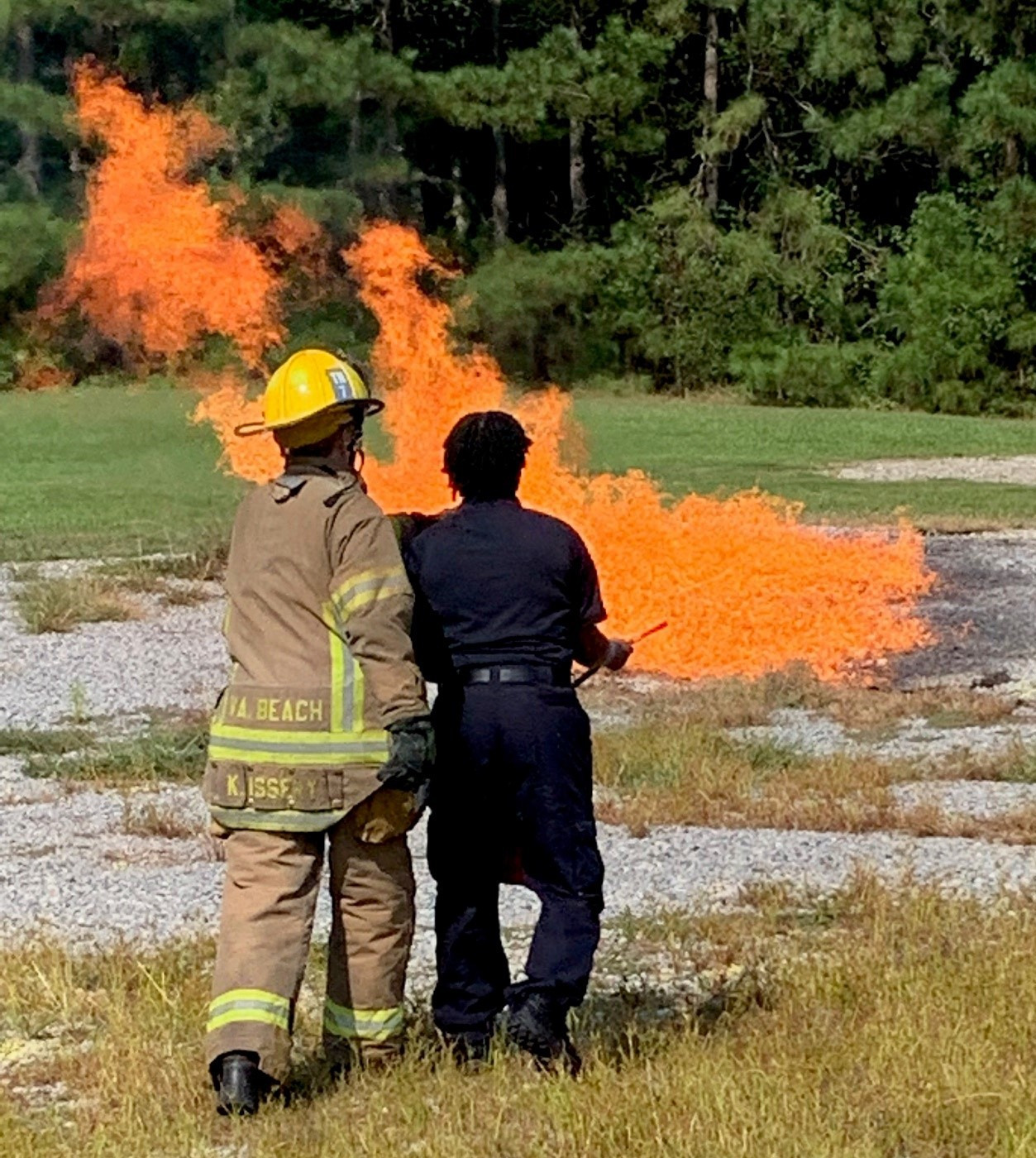
As the week went on, our class completed fire safety classroom training and interview-and-interrogation training. These blocks were the same as my previous academy, but I had to take them again in preparation for the written test, which I didn’t get to take because of my knee injury. But I'm not complaining. I love interview and interrogation and putting out fires with the Virginia Beach Fire Department! We also practiced proper application of shackles.
This Monday our classroom instruction included defensive tactics, chemical agents and inmate positional safety concerns. After the classroom we moved to the mat room (or the scene of the crime, a.k.a. my meniscus tear), and prepared to do hands-on defensive tactics training. The material covered was a review from the last academy, but it was a great refresher. I'm also happy that for this academy I have access to the demonstration videos the staff put together for the recruits to review and practice. I worked with different partners to go over the various techniques and refresh my skills.
I will rejoin the class on Oct. 3 once they’ve finished the defensive tactics training that I’ve already completed. In the meantime, I have stayed in contact with some of my classmates and it sounds like they are excelling. They have their first practical test on Monday, and I know how unnerving it is to go before a panel of instructors to demonstrate and be graded on all the pertinent tactics. I anxiously await word from my classmates to hear how they fared.
Our second LawFit assessment will be on Friday, Sept. 28. My fingers are crossed that my knee will be in good shape and I can get a gold rating like on my previous assessments. Until next time, wish us luck!
Photos by Public Information Officer Toni Guagenti and Deputy Recruit Margie Hobbs.
Sept. 9, 2022
The time has come! I was cleared by my orthopedic doctor after months of grueling boot camp-style physical therapy to resume full-duty status with no restrictions as of today! That means on Tuesday I will resume academy training and join Basic Academy Class 53-22.
The first class of my second VBSO academy experience will be transportation classroom training and practical evaluation. This class teaches recruits about the operational processes of preparing an inmate for travel for court or other needed services, such as hospital visits.
During this time, recruits are also trained on detailed inmate search techniques, conducting pat-downs and inspecting inmates’ clothing for any contraband or weapons. Hands-on training will be conducted to teach us how to handcuff and shackle inmates for transport. We must also learn to thoroughly search the vehicle used for transport prior to use and immediately following the transporting of inmates; this is the same process we followed when I was a police officer. The reason is to make sure the previous occupant did not conceal or leave behind contraband or weapons that another inmate could use against transporting deputies or other inmates. Also, if we find contraband, such as drugs or weapons, we charge the inmate responsible with possession of those items, which guarantees that the chain of evidence is preserved.
Next in the academy, we will learn about interviews and interrogations, interview rooms and lockup. One of my favorite assignments in the Virginia Beach Police Department was investigations. I thoroughly enjoyed using my communication skills to interview and, when necessary, interrogate people to gather investigative information. It is imperative that deputies receive this training because they must investigate incidents in the Virginia Beach Correctional Center. They must ascertain the facts of any situation that arises in the facility, such as who the aggressor is in a prisoner assault case, and identify any potential victims and witnesses. This training allows our class to be ready for future training blocks and practical evaluations in week 10: court testimony preparation and practical exercises.
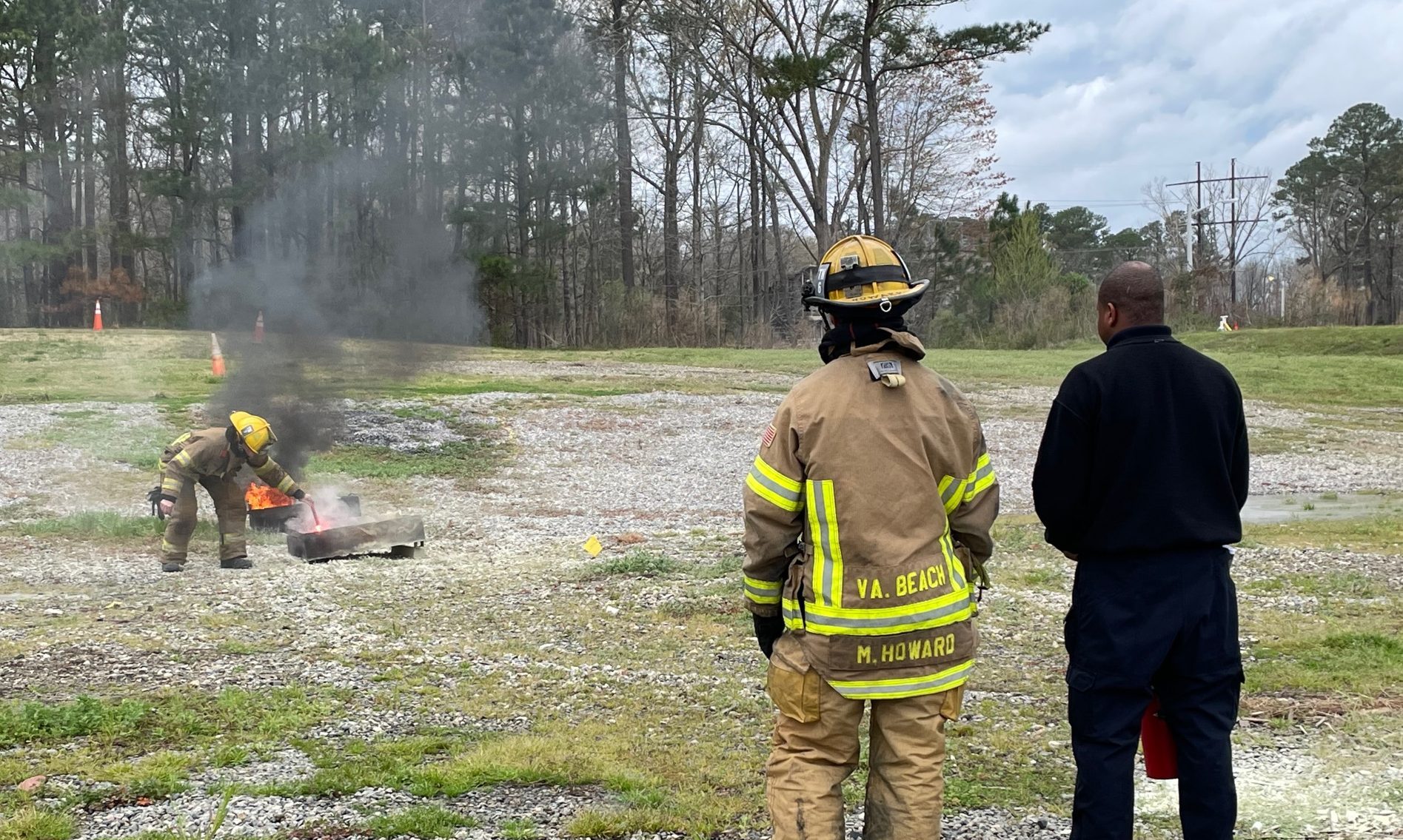
From here, we will move on to fire safety training. We will learn to recognize potential fire hazards, use fire extinguishers and evaluate the need for further assistance from the Virginia Beach Fire Department. There are several types of fire extinguishers that are used to treat different types of fires. Part of our training is a trip to the VBFD Fire Training Center to get experience putting out a fire using the types of extinguishers we keep in our facility. In my previous academy, Basic Academy Class 52-22, I learned that Cheetos and Fritos are highly flammable. The high oil content makes them easy to ignite. I have always known the neon orange powdered cheese and other ingredients in these types of snacks are not healthy, but flammable? This information is important for recruits to learn because inmates have snack foods and containers that can be used to start fires, and our deputies need to be ready to act quickly. Sheriff Ken Stolle has often said that being a deputy sheriff is like being a police officer, firefighter, medic and counselor all rolled into one, and he’s right. With fires being one of the biggest risks to the jail, we all have to be prepared to put on our "firefighter hat” at any time.
As I start in week 7 (out of 17) of the academy to finish my requirements from last class, I look forward to getting to know my classmates and finishing my training with them. As I step into a new team dynamic, I’m excited to learn each of my 19 new teammates’ personalities and skill sets as I assimilate into their evolving team dynamic. I contemplated wearing air bubble packing this time around, but I have faith in my physical training after having surgery in June, as well as the outstanding physical training I will receive (again) as part of this academy. The trainers are tough, but that is what we need to be strong and ready to respond to any scenario that we encounter. My next blog post will be on Sept. 23.
Wish me luck!
Aug. 5, 2022
Welcome back to the second installment of Back to Basics! As you may recall, I was in the VBSO’s Basic Academy Class 52-22, which began training in the first week of February 2022. Each week I chronicled our progress in this blog – Back to Basics – with the goal of giving the public an inside look at our training.
At the end of week 10, I was in the middle of a defensive tactics scenario when my knee bent the wrong way and I tore my meniscus. In a split second, my journey with BAC52-22 came to an end.
After my injury in April, I continued to follow the class's accomplishments and training for the Back to Basics blog while also working with my physical therapist trying to heal my injury. It was bittersweet. I enjoyed getting to be with my class as they finished their training, but sad that I couldn’t finish and graduate alongside them. On June 1, I watched as my academy classmates graduated, the culmination of 17 weeks of hard work. I was so proud of them and have continue to see them excel in their field training at the Virginia Beach Correctional Center and at community events.
Although my knee became much stronger during physical therapy, the meniscus damage required surgery. I went under the knife in mid-June. The surgery went well, and other than a few bumps in the road, my knee is on the road to recovery. I am thankful to have two very hard-charging physical therapists who challenge me – even though it feels like torture sometimes – and have developed an aggressive rehabilitation program to prepare my knee for the requirements of returning to full duty and the rigors of academy training. My expected return to the academy was in mid-October, but due to some scheduling changes in the curriculum, my first day back will be about a month earlier.
Fast forward to Aug. 1, when the VBSO’s Basic Academy Class 53-22 gathered at the Law Enforcement Training Academy to begin their 17-week training program. Although I am still on limited duty and won’t join them until September, I wanted to observe their first day and attend introductions. I let them know about my injury, the Back to Basics blog and my hopes for graduating with them.
Due to scheduling changes in this academy, my coursework will be intermittent from the time I start in September until mid-October, when I will attend training full-time. My blog entries will be intermittent as well, and I plan to publish biweekly until I return to the academy full-time. At that point, I will resume weekly blogs until I reach the finish line.
Thank you to the academy staff for working with me and my fellow Public Information Officers (PIOs) to facilitate this blog, including coordinating photos and giving us access to physical training and classroom instruction. We are grateful for the outstanding job they do, and I hope this blog shows the quality of the training they provide our deputies. Thank you also to my PIO partners, Toni Guagenti and Kathy Hieatt, for all of the amazing work they do taking photos and editing our message to make it blog-worthy!
And lastly, thanks to you for following our academy classes through this blog and taking an interest in the Virginia Beach Sheriff’s Office. We exist to serve and protect you, and I hope you enjoy learning more about us and what it takes to successfully complete the VBSO Basic Academy. See you in a month!

